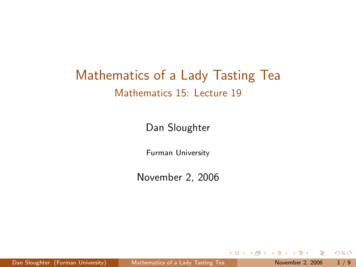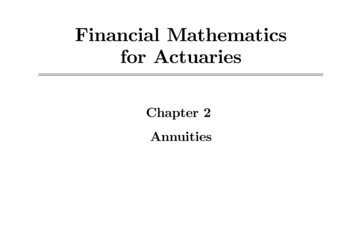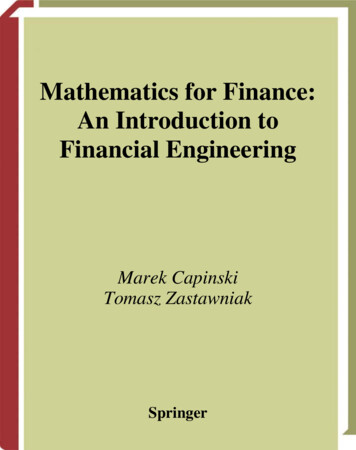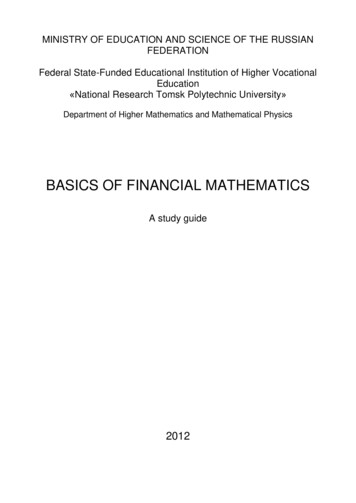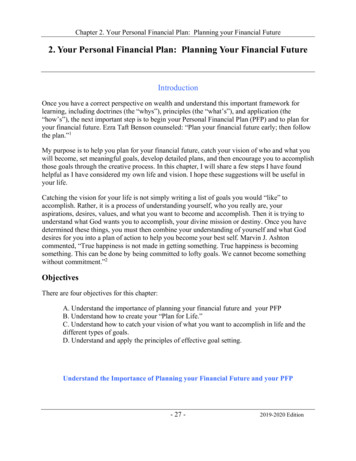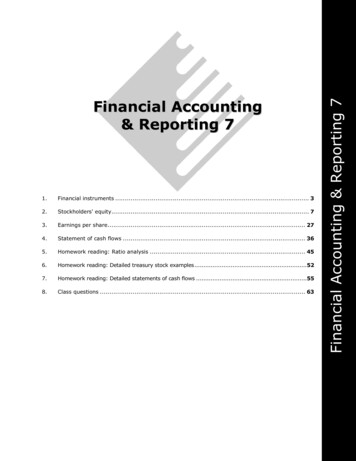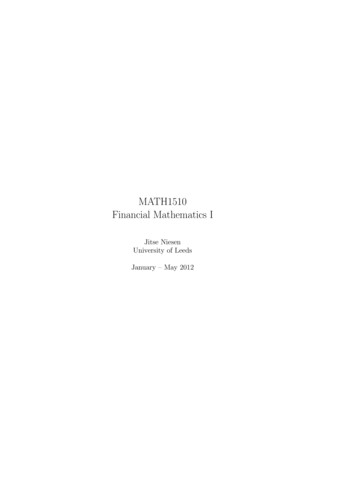
Transcription
MATH1510Financial Mathematics IJitse NiesenUniversity of LeedsJanuary – May 2012
Description of the moduleThis is the description of the module as it appears in the module catalogue.ObjectivesIntroduction to mathematical modelling of financial and insurance markets withparticular emphasis on the time-value of money and interest rates. Introductionto simple financial instruments. This module covers a major part of the Facultyand Institute of Actuaries CT1 syllabus (Financial Mathematics, core technical).Learning outcomesOn completion of this module, students should be able to understand the timevalue of money and to calculate interest rates and discount factors. They shouldbe able to apply these concepts to the pricing of simple, fixed-income financialinstruments and the assessment of investment projects.Syllabus Interest rates. Simple interest rates. Present value of a single futurepayment. Discount factors. Effective and nominal interest rates. Real and money interest rates. Compound interest rates. Relation between the time periods for compoundinterest rates and the discount factor. Compound interest functions. Annuities and perpetuities. Loans. Introduction to fixed-income instruments. Generalized cashflow model. Net present value of a sequence of cashflows. Equation of value. Internalrate of return. Investment project appraisal. Examples of cashflow patterns and their present values. Elementary compound interest problems.MATH1510i
Reading listThese lecture notes are based on the following books:1. Samuel A. Broverman, Mathematics of Investment and Credit, 4th ed.,ACTEX Publications, 2008. ISBN 978-1-56698-657-1.2. The Faculty of Actuaries and Institute of Actuaries, Subject CT1: Financial Mathematics, Core Technical. Core reading for the 2009 examinations.3. Stephen G. Kellison, The Theory of Interest, 3rd ed., McGraw-Hill, 2009.ISBN 978-007-127627-6.4. John McCutcheon and William F. Scott, An Introduction to the Mathematics of Finance, Elsevier Butterworth-Heinemann, 1986. ISBN 0-75060092-6.5. Petr Zima and Robert L. Brown, Mathematics of Finance, 2nd ed., Schaum’sOutline Series, McGraw-Hill, 1996. ISBN 0-07-008203.The syllabus for the MATH1510 module is based on Units 1–9 and Unit 11 ofbook 2. The remainder forms the basis of MATH2510 (Financial Mathematics II). The book 2 describes the first exam that you need to pass to become anaccredited actuary in the UK. It is written in a concise and perhaps dry style.These lecture notes are largely based on Book 4. Book 5 contains many exercises, but does not go quite as deep. Book 3 is written from a U.S. perspective, sothe terminology is slightly different, but it has some good explanations. Book 1is written by a professor from a U.S./Canadian background and is particularlygood in making connections to applications.All these books are useful for consolidating the course material. They allowyou to gain background knowledge and to try your hand at further exercises.However, the lecture notes cover the entire syllabus of the module.iiMATH1510
Organization for 2011/12LecturerJitse cs 8.22fTelephone35870 (from outside: 0113 3435870)LecturesTuesdays 10:00 – 11:00 in Roger Stevens LT 20Wednesdays 12:00 – 13:00 in Roger Stevens LT 25Fridays 14:00 – 15:00 in Roger Stevens LT 17Example classesMondays in weeks 3, 5, 7, 9 and 11,see your personal timetable for time and room.TutorsNiloufar Abourashchi, Zhidi Du, James Fung, and TongyaWang.Office hoursTuesdays . . . . . . . . (to be determined)or whenever you find the lecturer and he has time.Course workThere will be five sets of course work. Put your work inyour tutor’s pigeon hole on Level 8 of School of Mathematics. Due dates are Wednesday 1 February, 15 February,29 February, 14 March and 25 April.Late workOne mark (out of ten) will be deducted for every day.CopyingCollaboration is allowed (even encouraged), copying not.See the student handbook for details.ExamThe exam will take place in the period 14 May – 30 May;exact date and location to be announced.AssessmentThe course work counts for 15%, the exam for 85%.Lecture notesThese notes and supporting materials are available in theBlackboard VLE.MATH1510iii
ivMATH1510
Chapter 1The time value of moneyInterest is the compensation one gets for lending a certain asset. For instance,suppose that you put some money on a bank account for a year. Then, the bankcan do whatever it wants with that money for a year. To reward you for that,it pays you some interest.The asset being lent out is called the capital. Usually, both the capital andthe interest is expressed in money. However, that is not necessary. For instance,a farmer may lend his tractor to a neighbour, and get 10% of the grain harvestedin return. In this course, the capital is always expressed in money, and in thatcase it is also called the principal.1.1Simple interestInterest is the reward for lending the capital to somebody for a period of time.There are various methods for computing the interest. As the name implies,simple interest is easy to understand, and that is the main reason why we talkabout it here. The idea behind simple interest is that the amount of interestis the product of three quantities: the rate of interest, the principal, and theperiod of time. However, as we will see at the end of this section, simple interestsuffers from a major problem. For this reason, its use in practice is limited.Definition 1.1.1 (Simple interest). The interest earned on a capital C lentover a period n at a rate i is niC.Example 1.1.2. How much interest do you get if you put 1000 pounds for twoyears in a savings acount that pays simple interest at a rate of 9% per annum?And if you leave it in the account for only half ar year?Answer. If you leave it for two years, you get2 · 0.09 · 1000 180pounds in interest. If you leave it for only half a year, then you get 12 ·0.09·1000 45 pounds.As this example shows, the rate of interest is usually quoted as a percentage;9% corresponds to a factor of 0.09. Furthermore, you have to be careful thatthe rate of interest is quoted using the same time unit as the period. In thisMATH15101
example, the period is measured in years, and the interest rate is quoted perannum (“per annum” is Latin for “per year”). These are the units that are usedmost often. In Section 1.5 we will consider other possibilities.Example 1.1.3. Suppose you put 1000 in a savings account paying simpleinterest at 9% per annum for one year. Then, you withdraw the money withinterest and put it for one year in another account paying simple interest at 9%.How much do you have in the end?Answer. In the first year, you would earn 1·0.09·1000 90 pounds in interest, soyou have 1090 after one year. In the second year, you earn 1 · 0.09 · 1090 98.1pounds in interest, so you have 1188.10 ( 1090 98.1) at the end of the twoyears.Now compare Examples 1.1.2 and 1.1.3. The first example shows that if youinvest 1000 for two years, the capital grows to 1180. But the second exampleshows that you can get 1188.10 by switching accounts after a year. Even betteris to open a new account every month.This inconsistency means that simple interest is not that often used in practice. Instead, savings accounts in banks pay compound interest, which will beintroduced in the next section. Nevertheless, simple interest is sometimes used,especially in short-term investments.Exercises1. (From the 2010 exam) How many days does it take for 1450 to accumulate to 1500 under 4% p.a. simple interest?2. (From the sample exam) A bank charges simple interest at a rate of 7% p.a.on a 90-day loan of 1500. Compute the interest.1.2Compound interestMost bank accounts use compound interest. The idea behind compound interestis that in the second year, you should get interest on the interest you earned inthe first year. In other words, the interest you earn in the first year is combinedwith the principal, and in the second year you earn interest on the combinedsum.What happens with the example from the previous section, where the investor put 1000 for two years in an account paying 9%, if we consider compound interest? In the first year, the investor would receive 90 interest (9%of 1000). This would be credited to his account, so he now has 1090. Inthe second year, he would get 98.10 interest (9% of 1090) so that he endsup with 1188.10; this is the same number as we found before. The capital ismultiplied by 1.09 every year: 1.09 · 1000 1090 and 1.09 · 1090 1188.1.More generally, the interest over one year is iC, where i denotes the interestrate and C the capital at the beginning of the year. Thus, at the end of the year,the capital has grown to C iC (1 i)C. In the second year, the principalis (1 i)C and the interest is computed over this amount, so the interest isi(1 i)C and the capital has grown to (1 i)C i(1 i)C (1 i)2 C. Inthe third year, the interest is i(1 i)2 C and the capital has grown to (1 i)3 C.2MATH1510
This reasoning, which can be made more formal by using complete induction,leads to the following definition.Definition 1.2.1 (Compound interest). A capital C lent over a period n at arate i grows to (1 i)n C.Example 1.2.2. How much do you have after you put 1000 pounds for twoyears in a savings acount that pays compound interest at a rate of 9% perannum? And if you leave it in the account for only half ar year?Answer. If you leave it in the account for two years, then at the end you have(1 0.09)2 · 1000 1188.10,as we computed above. If you leave it in the account for only half a year, thenat the end you have (1 0.09)1/2 · 1000 1.09 · 1000 1044.03pounds (rounded to the nearest penny). This is 97p less than the 45 poundsinterest you get if the account would pay simple interest at the same rate (seeExample 1.1.2).Example 1.2.3. Suppose that a capital of 500 dollars earns 150 dollars ofinterest in 6 years. What was the interest rate if compound interest is used?What if simple interest is used?Answer. The capital accumulated to 650, so in the case of compound interestwe have to solve the rate i from the equation(1 i)6 · 500 650 (1 i)6 1.3 1 i 1.31/6 1.044698 . . . i 0.044698 . . .Thus, the interest rate is 4.47%, rounded to the nearest basis point (a basis pointis 0.01%). Note that the computation is the same, regardless of the currencyused.In the case of simple interest, the equation to solve 6 · i · 500 150, so150i 6·500 0.05, so the rate is 5%.Example 1.2.4. How long does it take to double your capital if you put it inan account paying compound interest at a rate of 7 12 %? What if the accountpays simple interest?Answer. The question is for what value of n does a capital C accumulate to 2Cif i 0.075. So we have to solve the equation 1.075n C 2C. The first step isto divide by C to get 1.075n 2. Then take logarithms:log(1.075n ) log(2) n log(1.075) log(2) n log(2) 9.58 . . .log(1.075)So, it takes 9.58 years to double your capital. Note that it does not matterhow much you have at the start: it takes as long for one pound to grow to twopounds as for a million pounds to grow to two million.The computation is simpler for simple interest. We have to solve the equation1 13 31 , so with simple interest it takes 13 13 yearsn · 0.075 · C C, so n 0.075to double your capital.MATH15103
More generally, if the interest rate is i, then the time required to double yourcapital islog(2)n .log(1 i)We can approximate the denominator by log(1 i) i for small i; this isthe first term of the Taylor series of log(1 i) around i 0 (note that, as iscommon in mathematics, “log” denotes the natural logarithm). Thus, we getn log(2)i . If instead of the interest rate i we use the percentage p 100i, andwe approximate log(2) 0.693 . . . by 0.72, we getn 72.pThis is known as the rule of 72 : To calculate how many years it takes you todouble your money, you divide 72 by the interest rate expressed as a percentage.Let us return to the above example with a rate of 7 12 %. We have p 7 12 so wecompute 72/7 12 9.6, which is very close to the actual value of n 9.58 wecomputed before.The rule of 72 can already be found in a Italian book from 1494: Summa deArithmetica by Luca Pacioli. The use of the number 72 instead of 69.3 has twoadvantages: many numbers divide 72, and it gives a better approximation forrates above 4% (remember that the Taylor approximation is centered aroundi 0; it turns out that it is slightly too small for rates of 5–10% and using 72instead of 69.3 compensates for this).Remember that with simple interest, you could increase the interest you earnby withdrawing your money from the account halfway. Compound interest hasthe desirable property that this does not make a difference. Suppose that youput your money m years in one account and then n years in another account,and that both account pay compount interest at a rate i. Then, after thefirst m years, your capital has grown to (1 i)m C. You withdraw that andput it in another account for n years, after which your capital has grown to(1 i)n (1 i)m C. This is the same as what you would get if you had kept thecapital in the same account for m n years, because(1 i)n (1 i)m C (1 i)m n C.This is the reason why compound interest is used so much in practice. Unlessnoted otherwise, interest will always refer to compound interest.Exercises1. The rate of interest on a certain bank deposit account is 4 21 % per annumeffective. Find the accumulation of 5000 after seven years in this account.2. (From the sample exam) How long does it take for 900 to accumulate to 1000 under an interest rate of 4% p.a.?4MATH1510
2.522final capitalfinal capital2.51.510.51.510.500246time (in years)81000simplecompound510interest rate (%)15Figure 1.1: Comparison of simple interest and compound interest. The leftfigure plots the growth of capital
These lecture notes are based on the following books: 1.Samuel A. Broverman, Mathematics of Investment and Credit, 4th ed., ACTEX Publications, 2008. ISBN 978-1-56698-657-1. 2.The Faculty of Actuaries and Institute of Actuaries, Subject CT1: Finan-cial Mathematics, Core Technical. Core reading for the 2009 examinations. 3.Stephen G. Kellison, The Theory of Interest, 3rd ed., McGraw-Hill, 2009 .

